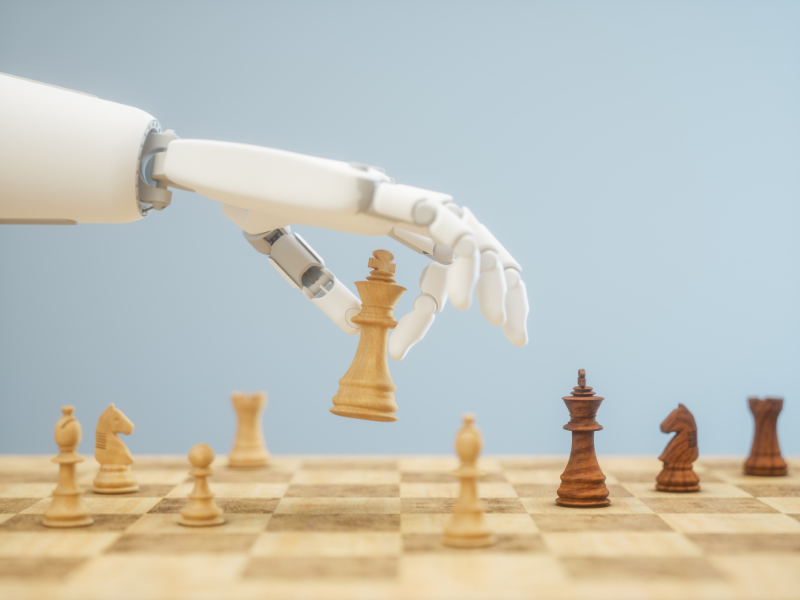Artificial technology (AI) has burst into every industry seemingly overnight, revolutionizing how we develop, produce and think about products. From software and automotive engineering to retail and the aerospace industry, AI offers remarkable opportunities for innovation and efficiency.
And the world is taking notice. According to a recent study, the adoption rate of AI is expected to gain significant traction in product development companies around the world by 2025. Can you afford to be left behind?
When it comes to product development, AI has the power to accelerate design processes, optimize manufacturing and personalize user experiences. However, it can also introduce risks such as data privacy concerns and algorithmic biases. The trick is to get the balance right so you can harness the potential of AI product optimization and effectively shape your product's features, future and success.
In this article, we explore the exciting opportunities product optimization with AI offers and how you can use it to optimize and perfect product features for new and existing products.
How Is AI Transforming Product Development?
You'd be forgiven for thinking that AI is all about OpenAI's ChatGPT. After all, this powerful language model forms the foundation for many AI-driven products. However, there are many players in the AI arena, each offering new and innovative ways to improve processes and save time and money. From gaining insights into what customers really think to analyzing large datasets in seconds, AI plays a pivotal role in reshaping product development as we know it and enhancing innovation and efficiency across every industry.
Here are just some of the ways AI is transforming product development and opening up new avenues for innovation:
- Automation of repetitive tasks: Enhance staff morale and reduce human error by getting AI to manage repetitive tasks. AI is excellent at handling and automating time-consuming and routine tasks, allowing engineers and designers to focus on more creative or complex areas of product development.
- Advanced data analysis: AI algorithms can be programmed to analyze gargantuan datasets quickly, helping you harness the power of AI-driven product enhancements. This data can be extracted into multiple formats, helping production and marketing teams understand market trends and consumer preferences that drive potential design improvements.
- Predictive capabilities: Imagine being able to see into the future to predict consumer behavior and product performance. AI offers powerful predictive capabilities that give you almost shaman-like insight, helping you to make proactive adjustments throughout the product life cycle.
- Optimized decision-making: AI assists teams in making confident decisions. From building a prototype to implementing AI-powered product features, AI helps you choose the best paths for development and deployment.
- Enhanced customization: Customer data can be the key to developing more personalized products that effectively meet your customers' needs and preferences.
The Product Life Cycle: How AI Influences Decisions and Drives Action
The product development life cycle is a complex and dynamic journey that involves streamlined collaboration between multiple disciplinary teams. Each team takes on different tasks throughout the process, from concept and idea generation to development and customer feedback. Product optimization with AI can be implemented at every stage of the life cycle. Let's explore how this could work.

Concept and Idea Generation
Complexities and uncertainty can hamper the ideation stage of product development. Machine learning for product optimization can significantly improve this phase in the life cycle by recognizing market trends, new demands and consumer preferences. From social media data to customer evaluations to sales statistics, AI can analyze all this valuable data to support the development of new products.
Defining Requirements
The success of your product relies on the precision and clarity of the initial requirements. A weak product is one that's irrelevant to its target market because it fails to solve the problem its customers expect it to. Businesses can harness advanced analytics to precisely identify and articulate user needs and requirements by implementing product optimization with AI strategies. This ensures all teams involved operate together with a unified vision and goal. Using AI technology to analyze vast silos of data and predict outcomes enables the setting of clear and actionable goals right from the start. The result is a streamlined and effective workflow and a product that targets its market and performs beautifully.
AI in Design and Prototyping
Product optimization with AI can also be applied in the design and prototyping phases. Using AI-powered generative design tools, teams can explore every potential combination of a problem, testing and implementing product features much faster than a human could achieve. In addition to speeding up the design process, these tools result in optimized creative products. AI can also simulate how a product will behave in various scenarios, which can significantly reduce the cost of using conventional prototyping processes.
Material Selection and Optimization
The success of a product often comes down to material selection and optimization. AI's machine learning capabilities can improve this process by predicting the performance and qualities of various materials. From examining material qualities and performance results to analyzing usage patterns, AI can suggest the best material for the job, guaranteeing durability and customer satisfaction. AI can also help businesses precisely forecast material requirements, maximize inventory and reduce waste and environmental impact.
Manufacturing and Supply Chain Management
With the rise of smart factories, AI is set to dramatically transform the manufacturing sector. AI product optimization in these facilities can refine production processes and even predict equipment failures before they occur. On a busy production line where downtime can hit the bottom line hard, this technology helps ensure continuous and efficient operations.
When it comes to supply chain management, AI can accurately predict demand, optimizing inventory leads. AI algorithms can analyze historical data and market trends to ensure products are available when and where they're needed.
Quality Assurance and Testing
Ensuring the product features you've worked so hard to implement are of the highest quality is critical. AI can be integrated into your quality assurance processes. From automated testing to anomaly identification, machine learning models can be programmed to spot faults that might otherwise be missed by the human eye or could be challenging to identify. AI can also help with real-time monitoring throughout the manufacturing process, identifying and correcting quality concerns as they occur.

Customer Feedback and AI-Driven Product Enhancements
The most effective products are those that are continually improved and evolve to cater to users' changing needs. In a world where innovation is constantly on your heels, challenging you to do better and stay ahead of the curve, AI-driven product enhancements cannot be ignored. From adding new features requested by your customer base to improving your product's most popular features, AI becomes a critical tool in further product development. Using Natural Language Processing (NLP) algorithms, AI can efficiently trawl through social media feedback, customer reviews and even your help desk interactions to give you the insights to improve your product and ensure customer satisfaction.
How We Can Help You Harness the Power of AI Product Optimization
Don't get left behind in the AI revolution. This technology is here to stay, and there's never been a better time to get your business ahead by harnessing AI product optimization tools and solutions. Whether you're in the design phase of a brand-new idea or you're interested in using AI to improve existing product features, we can help you get the best results. Contact Further today to find out more.








